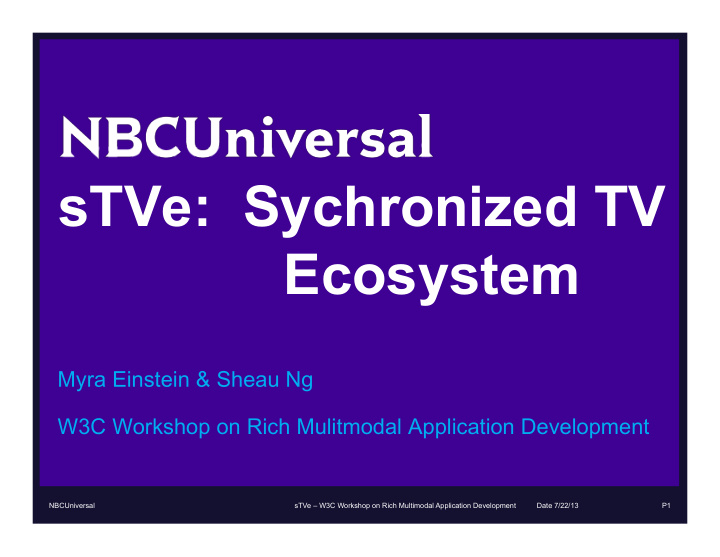



sTVe: Sychronized TV Ecosystem Myra Einstein & Sheau Ng W3C Workshop on Rich Mulitmodal Application Development NBCUniversal sTVe – W3C Workshop on Rich Multimodal Application Development Date 7/22/13 P1
sTVe (Pronounced “Stevie”) Synchronized Television Ecosystem What is sTVe? Set of protocols to allow a display renderer, such as a TV, to participate in a synchronized orchestration of multiple content that is delivered to the renderer in different paths. NBCUniversal sTVe – W3C Workshop on Rich Multimodal Application Development Date 7/22/13 P2
Motivation iTV lacks a Production/Distribution Ecosystem Video iTV ? Author ? Edit Distribute ? Consume NBCUniversal sTVe – W3C Workshop on Rich Multimodal Application Development Date 7/22/13 P3
The sTVe Ecosystem Content Identification Skills needed: - Fingerprint / Watermark / Signaling content identification Production & - Maintaining massively growing database of available content Operational Tools - Servicing 100,000s transactions per second Skills needed: - UI design for non-technical personnel Distribution - Knowledge of various Skills needed: production workflows - Syndication logic for targeting multiple types of devices - Integrations with other core Applications programmer technology Skills needed: - UI/UX Design for viewer interactions Responses and - HTML5, CSS, Javascript, other native device app technologies Special features Skills needed: - Response server: Ability to process 100,000s transactions/sec - Feature Server: Specialized knowledge for specific event (fantasy football, judging apps, etc) NBCUniversal sTVe – W3C Workshop on Rich Multimodal Application Development Date 7/22/13 P4
IP layer and Semantic Standard • Proliferation of IP connected devices that use HTML, CSS, Javascript for creating applications • Can use these technologies as a base for building a semantic layer on top • By defining a timeline object from which other event objects are hung, interactive applications can focus on user experience and less on basic data representations • The device/application is responsible for identifying the content being watched (ACR, sync-to-broadcast, etc). The application then marries objects on timeline to current temporal location. • For HTML applications, only a basic CSS reskin would be necessary to change the look and feel • Other non-HTML platforms could use these protocols as well, as the data objects don ’ t explicitly define the presentation layer and would provide the hooks necessary to invoke their own methods for applying styles NBCUniversal sTVe – W3C Workshop on Rich Multimodal Application Development Date 7/22/13 P5
SmartTV ACR Application Usecase NBCUniversal sTVe – W3C Workshop on Rich Multimodal Application Development Date 7/22/13 P6
Mobile/Tablet Application Usecase NBCUniversal sTVe – W3C Workshop on Rich Multimodal Application Development Date 7/22/13 P7
Benefits of sTVe Recap • Allows vendors to play to their strengths and helps open ecosystem up to become more mainstream • Allows Application creators to start with a framework for how data will be represented • Allows programmers to plug in new functionalities without replacing or replicating the entire system • Allows interactive content to follow video content into syndication for reruns and International audiences NBCUniversal sTVe – W3C Workshop on Rich Multimodal Application Development Date 7/22/13 P8
Future Work • Compile lessons learned from first prototypes developed • Further detailing in Browser-Server environment needed • W3C would be ideal place to develop these standards for browsers and the Multimodal Applications that sit on top of them. NBCUniversal sTVe – W3C Workshop on Rich Multimodal Application Development Date 7/22/13 P9
Thank you NBCUniversal sTVe – W3C Workshop on Rich Multimodal Application Development Date 7/22/13 P10
APPENDIX NBCUniversal sTVe – W3C Workshop on Rich Multimodal Application Development Date 7/22/13 P11
sTVe Conceptual Diagram NBCUniversal sTVe – W3C Workshop on Rich Multimodal Application Development Date 7/22/13 P12
Connected TV Screenshots NBCUniversal sTVe – W3C Workshop on Rich Multimodal Application Development Date 7/22/13 P13
sTVe Protocols and Standards Synchronous Content Protocol • Specify Communication Layer and Interactive Content Templates • JSON-Based • Abstract communication layer, and focus on how to request and receive synchronous content • One Client, using Web technologies (HTML, Javascript, CSS) for browser based apps • Utilizing any backend system that adheres to the spec • Alternate content for different display devices • Tablet, Smartphone, Laptop/Desktop, Connected TV, IP Connected Devices • Style classes provided to link to CSS or other method of applying style (native platforms) • Content Types: Poll, Trivia, Fun Fact, Chat, Data Table, Listing (headlines), E-Commerce, Video, Audio, Ad Unit, Link, Clear, Others NBCUniversal sTVe – W3C Workshop on Rich Multimodal Application Development Date 7/22/13 P14
sTVe Protocols and Standards Timeline Data Structure • Discreet Cues • Can have multiple display resources in each cue targeted to different areas on the screen • Multiple display resources in a cue can be user-advanced or auto-advanced like a slideshow • Each object has a duration, min-duration, and transition type. • Min duration is for determining if an object should be displayed if a user tunes in mid-broadcast Poll CTA Poll Results Fun Fact Chat Results Other Custom Event Timeline NBCUniversal sTVe – W3C Workshop on Rich Multimodal Application Development Date 7/22/13 P15
Recommend
More recommend